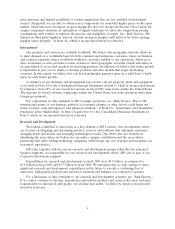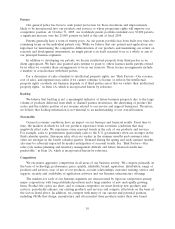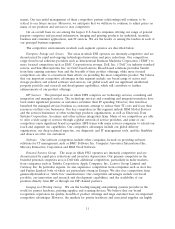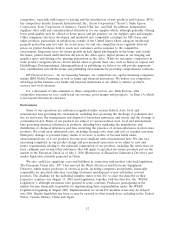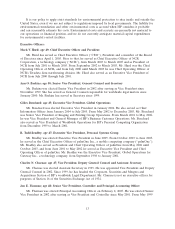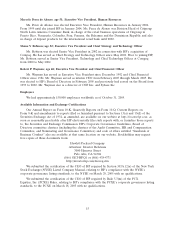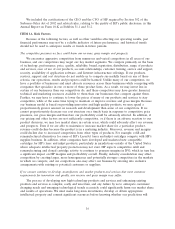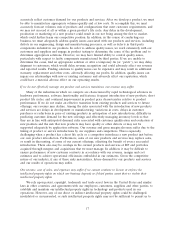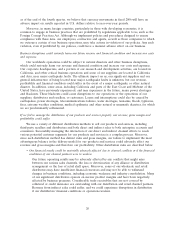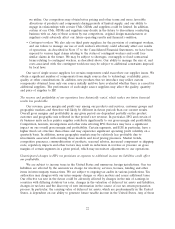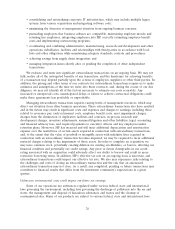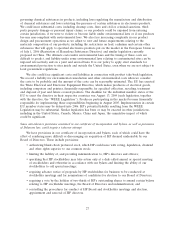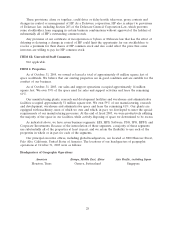HP 2005 Annual Report Download - page 22
Download and view the complete annual report
Please find page 22 of the 2005 HP annual report below. You can navigate through the pages in the report by either clicking on the pages listed below, or by using the keyword search tool below to find specific information within the annual report.take advantage of current market trends or otherwise to provide competitive advantages, which could
result in costly product redesign efforts, discontinuance of certain product offerings or other
competitive harm. Further, the laws of certain countries do not protect our proprietary rights to the
same extent as the laws of the United States. Therefore, in certain jurisdictions we may be unable to
protect our proprietary technology adequately against unauthorized third-party copying or use, which
could adversely affect our competitive position. Also, because of the rapid pace of technological change
in the information technology industry, much of our business and many of our products rely on key
technologies developed or licensed by third parties, and we may not be able to obtain or to continue to
obtain licenses and technologies from these third parties at all or on reasonable terms, or such third
parties may demand cross-licenses. Third parties also may claim that we or customers indemnified by us
are infringing upon their intellectual property rights. In recent years, individuals and groups have begun
purchasing intellectual property assets for the sole purpose of making claims of infringement and
attempting to extract settlements from large companies such as HP. Even if we believe that the claims
are without merit, the claims can be time-consuming and costly to defend and divert management’s
attention and resources away from our business. Claims of intellectual property infringement also might
require us to redesign affected products, enter into costly settlement or license agreements or pay
costly damage awards, or face a temporary or permanent injunction prohibiting us from marketing or
selling certain of our products. Even if we have an agreement to indemnify us against such costs, the
indemnifying party may be unable to uphold its contractual agreements to us. If we cannot or do not
license the infringed technology at all or on reasonable terms or substitute similar technology from
another source, our operations could suffer. Further, our costs of operations could be affected on an
ongoing basis by the imposition of copyright levies or similar fees by rights holders or collection
agencies in certain jurisdictions, primarily in Europe. In addition, it is possible that as a consequence of
a merger or acquisition transaction third parties may obtain licenses to some of our intellectual
property rights or our business may be subject to certain restrictions that were not in place prior to the
transaction. Consequently, we may lose a competitive advantage with respect to these intellectual
property rights or we may be required to enter into costly arrangements in order to terminate or limit
these rights.
Economic uncertainty could affect adversely our revenue, gross margin and expenses.
Our revenue and gross margin depend significantly on general economic conditions and the
demand for computing and imaging products and services in the markets in which we compete.
Economic weakness and constrained IT spending has previously resulted, and may result in the future,
in decreased revenue, gross margin, earnings or growth rates and problems with our ability to manage
inventory levels and collect customer receivables. We could experience such economic weakness and
reduced spending, particularly in our consumer businesses, due to the effects of high fuel costs. In
addition, customer financial difficulties have previously resulted, and could result in the future, in
increases in bad debt write-offs and additions to reserves in our receivables portfolio, inability by our
lessees to make required lease payments and reduction in the value of leased equipment upon its
return to us compared to the value estimated at lease inception. We also have experienced, and may
experience in the future, gross margin declines in certain businesses, reflecting the effect of items such
as competitive pricing pressures, inventory write-downs, charges associated with the cancellation of
planned production line expansion, and increases in pension and post-retirement benefit expenses.
Economic downturns also may lead to restructuring actions and associated expenses. Uncertainty about
future economic conditions makes it difficult for us to forecast operating results and to make decisions
about future investments. Delays or reductions in information technology spending could have a
material adverse effect on demand for our products and services, and consequently our results of
operations, prospects and stock price.
18



